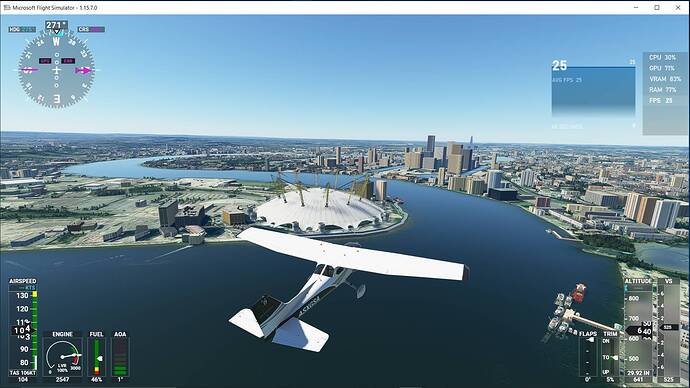Thanks for the thorough test report. 
Your temps indeed look alright, with and without the undervolting applied. So that explains why it’s not making that much of a difference.
I’ve had a go with the graphics settings in FS with World Update IV installed. The highest impact on frame rate has the “Terrain Level of Detail” and “Texture Resolution”.
Basically, Terrain LOD is obvious, as it defines the fidelity of the terrain. The higher the setting, the more the CPU and GPU have to process each frame.
The Texture Resolution on the other hand depends on the available amount of VRAM of your GPU and somewhat the amount of RAM. Like with the new RTX 3090s you can bump it up all the way, as those cards got roughly 24GB with the new GDDR6X RAM, which is a lot faster and bigger than on e.g. the GTX1050ti. That card is alright for 1080p, the new gen cards are for 2K resolutions and upwards, oriented towards processing 8K textures. Hence the big increase in speed and size. System RAM is part of a smooth experience as well. FS2020 allocates ram for game related data and textures. So 16GB of RAM or higher is recommended. Speed and latency do matter, however a good GPU is always more important.
Regarding my findings with the in-game VSYNC, I noticed on a 60Hz monitor with a PC with similar specs as yours, that when VSYNC is turned on, a frame rate limit of 30 yields the best results for the GPU. 20 bogged down the performance, so did 60 as the frame rate was not consistent enough to keep it above 60. The dips below 60 made the sim stutter. I then turned off the in-game VSYNC and tried all possible settings in the Nvidia Control Panel. Best results yield the “Fast” setting and no FPS limit set. It’s basically the same as turning VSYNC off, but frames in excess of the monitor refresh rate are dropped. So no tearing and less stress for the GPU, equals a smoother sim experience and less heat (if the game settings are tuned properly).
Turns out that VSYNC itself may cause stutters, compared to turning it off or setting it on fast. Same with limiting the frame rate.
All in all it comes down to the following settings which need to be adjusted, in order to fine tune the FPS and reduce the load on the hardware (for low to mid range PCs):
-
VSYNC:
“Off” in game, set “Vertical sync” to “Fast” in Nvidia Control Panel.
However, this is not set into stone, as every system reacts differently on this setting.
-
Render Scaling:
<= 100, preferably 90 with Image Sharpening enabled in Nvidia Control Panel
-
Terrain Level of Detail (has most noticeable impact on performance):
<= 70, anything higher really strain the CPU and GPU.
Lower than 30 makes the sim look more like FSX.
-
Trees & Grass and Bushes:
Medium, on real low end, set grass to low
-
Objects Level of Detail:
<= 50, preferably 30
-
Volumetric Clouds (also taxing on higher setting):
Medium, High is possible, but requires other settings to be dialed down
-
Texture Resolution (depends on available VRAM):
Medium
-
Texture Supersampling (high settings are taxing the CPU):
best is off, 2x2 is possible
-
Shadow Maps (depends on available VRAM):
768
-
Terrain Shadows (really a performance killer):
Off
-
Contact Shadows:
Low or Off
-
Ambient Occlusion (high settings are taxing the CPU):
Low. “Off” makes most cockpits look pale.
-
Reflections:
Not higher than Medium
-
Glass Cockpit Refresh Rate (high settings are taxing the CPU):
Not higher than Medium
All other settings are not as heavy on the system and are a matter of preference. Also “Anisotropic Filtering” does not affect performance, so 16x is recommended.
Asobo and the 3rd Party Developers are constantly improving the sim. So things keep changing a lot, which requires to test settings after every major update.
But these are my current recommendations on the game settings when running FS2020 on a low to mid range spec PC.



